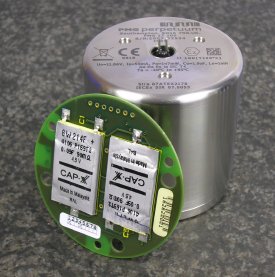Jun 4 2008
On June 3, engineers from Perpetuum and CAP-XX Limited will describe how Perpetuum's PMG17 vibration energy-harvesting micro-generator, together with a CAP-XX supercapacitor, allow wireless sensor system manufacturers to design battery-free condition monitoring systems that collect and report data on machinery for improved asset management. They will also present the results of a field trial at the Nyhamna gas plant in Norway to evaluate the system in a challenging industrial environment.
 PMG17 vibration energy-harvesting micro-generator, together with a CAP-XX supercapacitor, allow wireless sensor system manufacturers to design battery-free condition monitoring systems.
PMG17 vibration energy-harvesting micro-generator, together with a CAP-XX supercapacitor, allow wireless sensor system manufacturers to design battery-free condition monitoring systems.
Plants and refineries monitor pumps, machines and processes to ensure optimum safety, up-time and efficiency.
Condition monitoring solutions have traditionally involved maintenance engineers walking around to collect data, or the use of battery-powered wireless sensors. Engineers' time is valuable, and batteries may survive only two to five years in such harsh environments, so in plants with thousands of battery-powered wireless sensor nodes, the cost of replacing and disposing of batteries is also significant.
Supercapacitor complements micro-generator to power battery-free wireless sensor networks:
The PMG17 microgenerator converts unused mechanical vibration into useable electrical energy. After being stored in a CAP-XX supercapacitor, this energy can power wireless sensor nodes indefinitely.
The supercapacitor stores the energy harvested by the PMG17 micro-generator (a low but steady source of between 0.5mW and 50mW) and then delivers the peak power needed to transmit sensor condition data over wireless networks such as IEEE 802.15.4 (Zigbee) and 802.11 (WLAN). The output of the micro-generator can easily cover the power needs of intermittent radio sensor systems such as Wireless HART, SP-100 and Wi-Fi in industrial applications, but its output impedance is too high to supply the 10s to 100s of milliwatts required by sensor nodes during data collection and transmission. The high capacitance and low equivalent series resistance (ESR) of the supercapacitor provides approximately one second of peak power to transmit data.
"The micro-generator and supercapacitor combination eliminates battery reliability issues and time-consuming maintenance, while enabling significant savings in operational costs and energy use," said Dr. Stephen Roberts, technical manager for Perpetuum.
CAP-XX vice president of applications engineering, Pierre Mars, will present the collaborative paper which was co-authored by Perpetuum senior engineer, John Parker, at the Darnell nanoPower forum, June 2 - 4 in Irvine, California.
Mars commented, "Wireless system manufacturers can now easily design battery-free systems using this 'fit and forget' self-generating power source."
The Nyhamna gas plant in Norway used the PMG17 and CAP-XX supercapacitors to power wireless sensor nodes in its network during a field trial, which is now operational. Operating faultlessly despite a wide range of temperatures, the sensors monitored the condition of rotating equipment, the main culprit in production shutdowns, reporting temperature and overall vibration every five minutes.